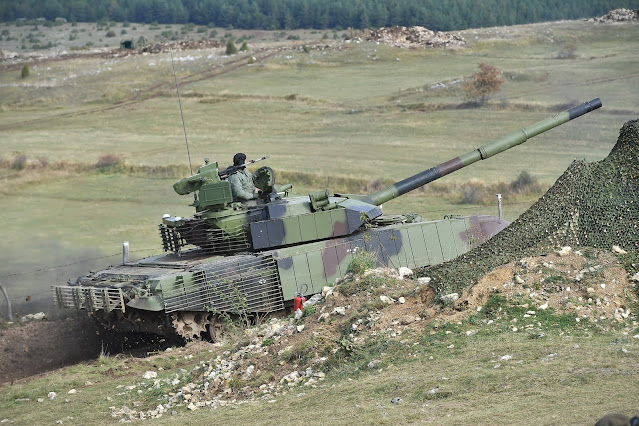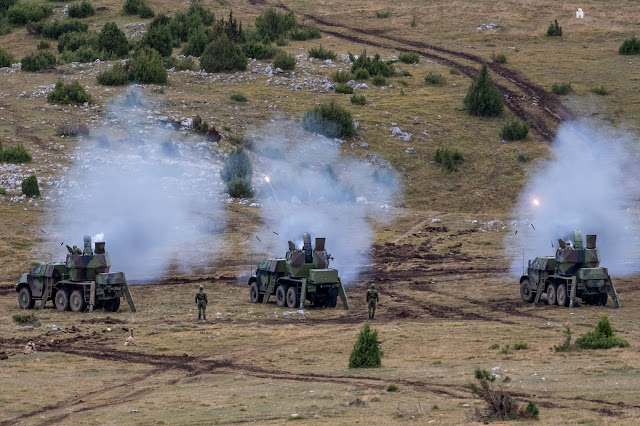The live-fire joint tactical exercise “Joint Action 2020“ at the “Pešter“ provisional training ground.
About 2,800 members of the Serbian Armed Forces and the Ministry of Defence, more than 150 combat and non-combat vehicles and systems and about 40 aircraft participated in the exercise "Joint Action 2020". Among them are a large number of modernized assets and assets developed by the Serbian defence industry, which were engaged jointly for the first time in one such exercise.
EXERCISE
The scenario of exercise "Joint Action 2020" is as follows: through coordinated activities, enemy armed forces have performed an armed attack and temporarily occupied a part of the Serbian territory with two battle groups that are waiting for the arrival of new troops to reinforce them.
Serbian Armed Forces jointly performed an offensive operation in order to expel the enemy forces, protect the local population and establish peace and stability.
The exercise started with the action of the Air Defence artillery-missile units whose objective was to destroy the spotted enemy aircraft, achieve air supremacy and create favourable conditions for the joint forces to carry out an offensive operation. The Air Defence PASARS and PANTSIR artillery batteries and one missile section were engaged in the execution of the task, while the upgraded Giraffe radar performed air surveillance and target acquisition.
After achieving air supremacy, in the second part of the exercise, reconnaissance of enemy dispositions was first carried out by CH-92 UAVs, Vrabac (Sparrow) and AP 100-C drones.
The battle group set out to execute the task, with an armoured reconnaissance company in a BRDM-2MS armoured reconnaissance vehicle providing security at the front. The company's surveillance group performed reconnaissance using the MIP-3 multisensor reconnaissance platforms on the BOV KIV combat vehicle. There were also two sniper pairs equipped with ghillie camouflage suits.
The third part of the exercise showed the action of a MiG-29 and the fight in which fighter aircraft engaged in a dogfight. MiG-29 aircraft also provided fighter cover to the bomber-fighter striking force in order to create conditions for the execution of battlefield air interdiction.
Enemy targets were engaged by several groups of bomber-fighters, modernized EAGLES armed with guns, missiles and lethal bombing weapons.
The fourth part of the exercise was characterised by the artillery-missile support of the fire team which consisted of the 155mm "NORA-B52" self-propelled gun-howitzer artillery battery, the 122mm GVOZDIKA self-propelled howitzer artillery battery, a reinforced battery of upgraded and digitized 128 mm M-17 OGANJ self-propelled multiple rocket launchers, the MORAVA multiple rocket launcher, the OGANj M-18 modular multiple rocket launcher and a 120 mm mortar platoon.
Given the diversity of calibres of the artillery-missile weapons that engage targets, for the synchronization of simultaneous action, portable artillery fire control observation devices are used and universal portable artillery-computer stations, which perform ballistic computation and send the results to digital control consoles for each individual weapon.
In the last three years, more than 20 different types of artillery weapons and equipment have been introduced into the armament of the Serbian Armed Forces, which has created the basis for a significant improvement of artillery capabilities.
In the fifth part of the exercise, combat aviation and attack helicopters were engaged.
For the first time in 20 years, the MiG-29 engaged ground targets with S-8 missiles. MiGs can engage ground targets with a wide range of weapons: unguided air-to-surface missiles, different calibre bombs and a 30 mm gun.
After MiG-29s, a group of Super Galeb G-4 aircraft engaged enemy targets. The aircraft came in sweeping flight at the altitudes of up to 100 m, using the terrain configuration to avoid enemy air defence.
Then, attack helicopters followed. First, the Mi-35 attack helicopters armed with ATAKA radio guided anti-tank missiles conducted a raid, engaging ground targets. Next, Mi-17V5 helicopters armed with unguided S-8 missiles fired, followed by a covert approach and action of GAMA helicopters.
In the sixth part of the exercise, the modernized M80 AB-1 infantry combat vehicle, the POLO М-83 anti-tank launcher, the LAZAR-3 armoured wheeled vehicle, the modernized M-84 AS-1 tank and the M-84 tank were engaged.
During the attack, the modernized missile system KUB provided protection to the battle group against air attacks, and the combat vehicle PANTSIR was engaged to provide air defence to the battle group, parachute and helicopter landing against sudden reconnaissance and air attacks.
The seventh part of the exercise started with a special parachute landing performed by a group of 30 paratroopers from the 63rd Parachute Brigade jumping from an An-26 aircraft from an altitude of 3,000 meters, in one flight, with the task of destroying the remaining enemy forces.
In order to create conditions for the helicopter landing, the troops of the 72nd Special Operations Brigade arrived in three columns of MILOŠ armoured combat vehicles. Synchronized and simultaneous action of Special Forces against the enemy created favourable conditions for carrying out the helicopter landing.
A group of Mi-17, Mi-8, Mi-35 and X-145 helicopters came next in a vertical manoeuvre in which members of the 72nd Special Operations Brigade and the 63rd Parachute Brigade were transported in order to neutralize the remaining enemy groups. Two remotely controlled MALI MILOš unmanned platforms were also unloaded from the helicopter.
Special Forces teams were equipped in accordance with the 1500 project, which includes 26 different types of state-of-the-art weapons and equipment.
The exercise ended with a demo jump by members of the 63rd Parachute Brigade with the flags of the Republic of Serbia and the Serbian Armed Forces. The demo jump was performed by Sergeant Major First Class Radmila Đurić and Sergeant Major Milan Svetozarević.
The joint tactical exercise "Joint Action 2020" presented a part of the capabilities of the units of the Serbian Armed Forces to conduct joint forces operations. The ability of some of the Serbian Armed Forces’ units to perform air and air defence operations and provide air support was demonstrated, as well as the offensive operations of Army units and the landing of special forces.
































No comments:
Post a Comment